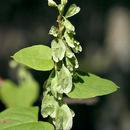Comments
provided by eFloras
Fallopia scandens has a complex nomenclatural history, which in North America usually involves three taxonomic elements:
F. scandens and
F. cristata, both native in North America, and
F. dumetorum, which is native in Europe. Achene and perianth characters have been used to distinguish these elements, but variable and intergrading morphologies have caused taxonomists to combine them variously. Morphometric (S. T. Kim et al. 2000) and flavonoid (M. H. Kim et al. 2000) studies suggest that
F. scandens and
F. dumetorum are distinct species. Where
F. scandens is absent, European specimens of
F. dumetorum are distinctive. This distinction is far less clear in North America, where both species occur. Experience suggests that many North American herbarium specimens attributed to
F. dumetorum are misidentified.
Fallopia cristata has been distinguished from F. scandens and F. dumetorum by its smaller fruiting perianths (5-7[-9] mm) bearing narrower (1.2-1.7 mm wide), undulate-crenate or lacerate wings, and smaller achenes (2.1-2.7 mm). Extreme forms are easily identified; some specimens grade gradually into F. scandens, making recognition of F. cristata of questionable utility. S. T. Kim et al. (2000) used morphometric studies as a basis for recommending that F. cristata is best treated as a variety of F. scandens.
- license
- cc-by-nc-sa-3.0
- copyright
- Missouri Botanical Garden, 4344 Shaw Boulevard, St. Louis, MO, 63110 USA
Description
provided by eFloras
Herbs, perennial or annual, not rhizomatous, 1-5 m. Stems scandent or sprawling, freely branched, herbaceous, glabrous or papillose to scabrid, not glaucous. Leaves: ocrea usually deciduous, tan or brown, cylindric to funnelform, 1-6 mm, margins oblique, face not fringed with reflexed hairs and slender bristles at base, otherwise glabrous or scabrid; petiole 0.5-10 cm, glabrous or scabrid in lines; blade cordate, truncate-deltate, or hastate, 2-14 × 2-7 cm, base cordate, margins wavy, scabrid, apex acuminate, abaxially and adaxially faces glabrous or papillose to scabrid, not glaucous, the abaxial rarely minutely dotted. Inflorescences axillary, erect or spreading, racemelike, 1-28 cm, axes scabrid; peduncle 0.1-7 cm or absent, scabrid. Pedicels ascending or spreading to reflexed, articulated distally, 4-8 mm, glabrous. Flowers bisexual, 3-6 per ocreate fascicle; perianth accrescent in fruit, green to white or pinkish, 3.8-8 mm including stipelike base, glabrous; tepals elliptic to obovate, apex obtuse to acute, outer 3 winged; stamens 8; filaments flattened proximally, pubescent proximally; styles connate; stigmas capitate. Achenes included, dark brown to black, 2-6 × 1.4-3.5 mm, shiny, smooth; fruiting perianth glabrous, wings undulate or crinkled, rarely flat, (0.7-)1.5-2.1 mm wide, decurrent on stipelike base nearly to articulation, margins wavy-crenate to incised or lacerate, rarely entire. 2n = 20.
- license
- cc-by-nc-sa-3.0
- copyright
- Missouri Botanical Garden, 4344 Shaw Boulevard, St. Louis, MO, 63110 USA
Distribution
provided by eFloras
Alta., Man., N.B., N.S., Ont., P.E.I., Que., Sask.; Ala., Ark., Conn., Del., D.C., Fla., Ga., Ill., Ind., Iowa, Kans., Ky., La., Maine, Md., Mass., Mich., Minn., Miss., Mo., Nebr., N.H., N.J., N.Y., N.C., N.Dak., Ohio, Okla., Pa., R.I., S.C., S.Dak., Tenn., Tex., Vt., Va., W.Va., Wis., Wyo.
- license
- cc-by-nc-sa-3.0
- copyright
- Missouri Botanical Garden, 4344 Shaw Boulevard, St. Louis, MO, 63110 USA
Synonym
provided by eFloras
Polygonum scandens Linnaeus, Sp. Pl. 1: 364. 1753; Bilderdykia cristata (Engelmann & A. Gray) Greene; B. scandens (Linnaeus) Greene; B. scandens var. cristata (Engelmann & A. Gray) C. F. Reed; Fallopia cristata (Engelmann & A. Gray) Holub; Polygonum cristatum Engelmann & A. Gray; P. dumetorum var. scandens (Linnaeus) A. Gray; P. scandens var. cristatum (Engelmann & A. Gray) Gleason; Reynoutria scandens (Linnaeus) Shinners; R. scandens var. cristata (Engelmann & A. Gray) Shinners; Tiniaria cristata (Engelmann & A. Gray) Small; T. scandens (Linnaeus) Small
- license
- cc-by-nc-sa-3.0
- copyright
- Missouri Botanical Garden, 4344 Shaw Boulevard, St. Louis, MO, 63110 USA
Fallopia scandens: Brief Summary
provided by wikipedia EN
Fallopia scandens, the climbing false buckwheat, is a species of Fallopia native to North America. It is a herbaceous perennial plant which grows from to 1–5 m (3–16 ft) tall. Although they are semi-erect during bloom, when they are producing fruit, they hang from their pedicels in a downward position. Both the fruit and flower are greenish-white in appearance. In North America, it is often misidentified with Fallopia dumetorum, a species endemic to Europe.
- license
- cc-by-sa-3.0
- copyright
- Wikipedia authors and editors

